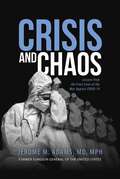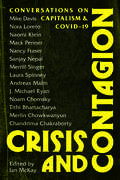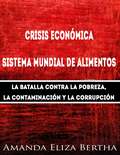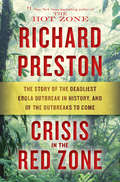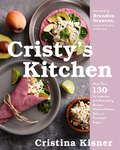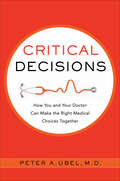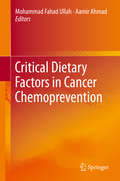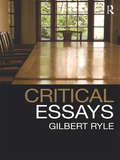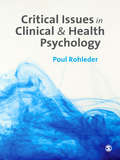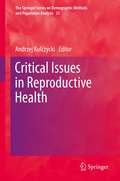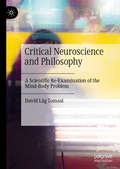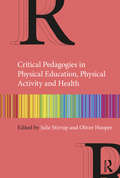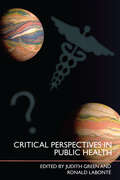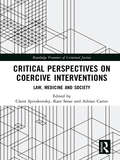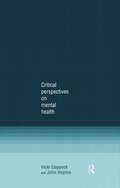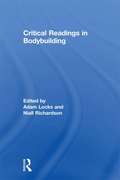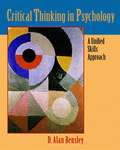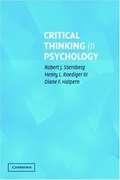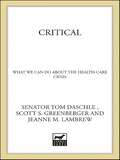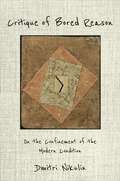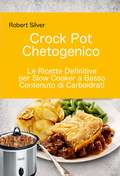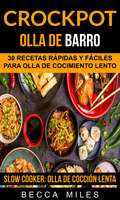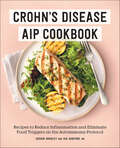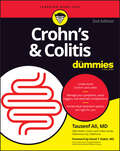- Table View
- List View
Crisis and Chaos: Lessons from the Front Lines of the War Against COVID-19
by Jerome M. AdamsHard truths and surprising insights about our COVID-19 response from America&’s former top doctor.When COVID-19 began spreading rapidly, the world was taken by surprise. As the ensuing pandemic raged, we faced one constant—a lack of consistent, scientifically sound, and trusted information about dangers, risks, and mitigation strategies that the average person could understand and put into practice to keep themselves and their families safe. Politicians, opportunists, and agenda-driven media personalities spread misinformation for an array of purposes, leaving most of the public scratching their heads, wondering what was true and what wasn&’t. Now, the former Surgeon General of the United States—freed from the many constraints he worked under in public office—reveals critical lessons learned from both mistakes and successes overlooked during the pandemic. He explains what we need to know to create a safer environment for individuals, families, and communities, how we can respond better to the next threat, why we keep making the same mistakes, and why we must promote health equity for all. As Dr. Adams explains, the best public health policies are the ones that begin at home and come about as people in local communities work together to find solutions that fit their specific priorities and needs. Only through this bottom-up, community-driven approach will we be able to turn down the volume on the distracting noise, finally make our way out of and recover from a once-in-a-century pandemic, and prepare ourselves for inevitable future health crises.
Crisis and Contagion: Conversations on Capitalism and Covid-19
by Ian McKayCrisis and Contagion is a selection of fourteen interviews conducted by Ian McKay of the Wilson Institute at McMaster University. Interviews with Nancy Fraser, Mike Davis, Mack Penner, Andreas Malm, and Merrill Singer explore capitalism’s organic crisis and the ways it has made this and future pandemics inevitable. Nora Loreto, Tithi Bhattacharya, Chandrima Chakraborty, Merlin Chowkwanyun, and Sanjay Nepal discuss the experiences of ordinary people in the pandemic. J. Michael Ryan, Laura Spinney, Naomi Klein, and Noam Chomsky explore the long-term effects and likely historical legacy of a pandemic that has changed millions of lives–and, maybe, the trajectory of human civilization. These scholars propose that to understand the impact of Covid-19, we have to understand the conflictual history of capitalism–and to ward off future pandemics, we need to start building a post-capitalist alternative to the disease-generating and highly unequal global neoliberal order. As capitalist forces work to shove what we have learned from the Covid-19 pandemic down the memory hole, Crisis and Contagion offers a must-read for those wanting to seize this moment of change and revolution.
Crisis económica: Sistema mundial de alimentos - La batalla contra la pobreza, la con...
by José Pedro Galindo Macías Amanda Eliza BerthaEl sistema mundial de alimentos se encuentra en grave peligro. La gente se muere de hambre porque sus alimentos están siendo acaparados, son vendidos a otros países o simplemente no se están produciendo. Este libro le echa una mirada a la crisis económica, con especial atención al sistema mundial de alimentos.
Crisis in the Red Zone: The Story of the Deadliest Ebola Outbreak in History, and of the Outbreaks to Come
by Richard PrestonThe 2013–2014 Ebola epidemic was the deadliest ever—but the outbreaks continue. Now comes a gripping account of the doctors and scientists fighting to protect us, an urgent wake-up call about the future of emerging viruses—from the #1 bestselling author of The Hot Zone, now a National Geographic original miniseries. <P><P> This time, Ebola started with a two-year-old child who likely had contact with a wild creature and whose entire family quickly fell ill and died. The ensuing global drama activated health professionals in North America, Europe, and Africa in a desperate race against time to contain the viral wildfire. <P><P>By the end—as the virus mutated into its deadliest form, and spread farther and faster than ever before—30,000 people would be infected, and the dead would be spread across eight countries on three continents. In this taut and suspenseful medical drama, Richard Preston deeply chronicles the outbreak, in which we saw for the first time the specter of Ebola jumping continents, crossing the Atlantic, and infecting people in America. <P><P> Rich in characters and conflict—physical, emotional, and ethical—Crisis in the Red Zone is an immersion in one of the great public health calamities of our time. Preston writes of doctors and nurses in the field putting their own lives on the line, of government bureaucrats and NGO administrators moving, often fitfully, to try to contain the outbreak, and of pharmaceutical companies racing to develop drugs to combat the virus. He also explores the charged ethical dilemma over who should and did receive the rare doses of an experimental treatment when they became available at the peak of the disaster. <P><P> Crisis in the Red Zone makes clear that the outbreak of 2013–2014 is a harbinger of further, more severe outbreaks, and of emerging viruses heretofore unimagined—in any country, on any continent. In our ever more interconnected world, with roads and towns cut deep into the jungles of equatorial Africa, viruses both familiar and undiscovered are being unleashed into more densely populated areas than ever before. <P><P>The more we discover about the virosphere, the more we realize its deadly potential. Crisis in the Red Zone is an exquisitely timely book, a stark warning of viral outbreaks to come. <P><P><b> A New York Times Bestseller</b>
Cristy's Kitchen: More Than 130 Scrumptious and Nourishing Recipes Without Gluten, Dairy, or Processed Sugar0
by Cristina KisnerEnjoy an abundance of healthful gluten-free and dairy-free recipes—all inspired by a mother’s passionIn 2019, after a bankruptcy left her family with nothing, Cristy Kisner; her husband, Sebastian; and their five daughters moved from Peru to Roswell, Georgia, to give them a better future and to fulfill Cristy’s dream of opening a healthy café in the United States. When the Covid-19 lockdown came, they never closed their doors, working sixteen-hour days for a year. In March 2021, Brandon Stanton, the creator of Humans of New York, became a regular customer and fell in love with the food at the café and Cristy’s incredible story. He wrote about Cristy and sponsored a fundraiser, and her moving story went viral, allowing the family to stay afloat and continue to live their American dream. The food at Cristy’s Kitchen is gluten-free, dairy-free, organic, nourishing, and thoroughly tasty. Back in Peru, Cristy had developed her recipes after two of her daughters experienced medical issues ranging from allergic rhinitis to digestive problems to an autoimmune disease. They switched to organic ingredients; removed dairy, gluten, and processed foods from their diets; and got each diagnosis under control. Her daughters’ special packed lunches gained the attention of other parents, and Cristy started teaching classes on healthy food prep, which evolved into the dream of having her own bakery and café serving sweet and savory baked goods, prepared foods, and more, many inspired by favorite ingredients from her native Peru. Cristy provides helpful health information and sources on the more unusual ingredients in the book, including those she’s refined into her celebrated gluten-free baked goods. The delicious and healthful recipes in this book include favorites for breakfast, lunch, dinner, snacks, and desserts, including:Golden Milk PancakesSpiced Pumpkin Smoothie Bowl with Caramelized BananasPear, Spinach, and Fennel Soup with Chicken, Avocado, and Cashew ParmesanYucca Gnocchi with Carrot Greens PestoStuffed Poblanos with LambPaleo Molten Lava CakePassion Fruit Super Gummy CandiesThe incredible stories and recipes in Cristy’s Kitchen will inspire you to cook and eat more healthfully, cherish the blessings in your life—and understand the miracles that can happen when love and determination go hand in hand.
Critical Decisions: How You and Your Doctor Can Make the Right Medical Choices Together
by Peter A. UbelWe've all been there, sittinguncomfortably in a paper gownas a doctor impassively describesour prognosis. Sometimes it's simple andtreatable. Other times we get news wecan't fathom and then are faced withdecisions that are literally life and death.In this revolutionary book, physician,behavioral scientist, and bioethicist PeterUbel, M.D., reveals how hidden dynamicsin the doctor/patient relationship keepus and our loved ones from making thebest medical choices. From doctors whostruggle to explain, to patients who failto properly listen, countless factors alterthe course of our care, causing things togo seriously awry.With riveting stories of Ubel's own experiencein the field, his groundbreakingresearch, and his personal journey walkingloved ones through difficult treatmentchoices, Critical Decisions will foreverchange the way we communicate insidehospitals and medical offices, wherethoughtful decision making matters themost. Dr. Ubel has been on both endsof the stethoscope, and in this book,he shows how patients and doctorscan learn to become partners and worktogether to make the right choices. Fromchoosing to get surgery, to discussingthe side effects of a blood pressure medication,we can finally discover the toolsto improve communication, understandthe issues, and make confident decisionsfor our future health and happiness.
Critical Dietary Factors in Cancer Chemoprevention
by Aamir Ahmad Mohammad Fahad UllahThis book focuses on the prophylactic potential of diet-derived factors in primary prevention of cancer. It is written by a group of highly reputed experts in the area of dietary agents and cancer chemoprevention. The translational potential of dietary factors from epidemiological, laboratory and clinical studies as prevention strategy in normal and risk populations is highlighted. The work presents options of routine inclusion of specific dietary regimens for prevention as well as therapeutic strategy for better management through adjuvant interventions in cancer treatment.
Critical Essays: Collected Papers Volume 1
by Gilbert RyleGilbert Ryle was one of the most important and controversial philosophers of the Twentieth century. Long unavailable, Critical Essays: Collected Papers Volume 1 includes many of Ryle’s most important and thought-provoking papers. This volume contains 20 critical essays on the history of philosophy, with writing on Plato, Locke and Hume as well as important chapters on Russell and Wittgenstein. It also includes three essays on phenomenology, including Ryle’s famous review of Martin Heidegger’s Being and Time first published in 1928. Although Ryle believed phenomenology ‘will end in self-ruinous subjectivism or in a windy mysticism’ his review also acknowledged that Heidegger was a thinker of great originality and importance. While surveying the developments in the philosophy of language and philosophical logic, Ryle sets out his own conception of the philosophers’ role against that of his predecessors and contemporaries. Together with the second volume of Ryle’s collected papers Collected Papers Volume 2 and the new edition of The Concept of Mind, all published by Routledge, these outstanding essays represent the very best of Ryle’s work. Each volume contains a substantial introduction by Julia Tanney, and both are essential reading for any student of twentieth-century philosophies of mind and language. Gilbert Ryle (1900 -1976) was Waynflete Professor of Metaphysics and Fellow of Magdalen College Oxford, an editor of Mind, and a president of the Aristotelian Society. Julia Tanney is Senior Lecturer at the University of Kent, and has held visiting positions at the University of Picardie and Paris-Sorbonne.
Critical Issues in Clinical and Health Psychology
by Dr Poul RohlederThis textbook gives a clear and thought-provoking introduction to the critical issues related to health, illness and disability in clinical and health psychology. Challenging some of the preconceptions of ill-health of the biomedical approach, the book explores how health and illness is often shaped by factors such as culture, poverty, gender and sexuality, and examines how these influences impact on the experience and treatment of physical and mental illness as well as disability. Students are introduced to literature from disciplines other than psychology to provide multiple perspectives on these complex issues.<P><P> Critical Issues in Clinical and Health Psychology is a key textbook for undergraduate and postgraduate students taking courses in health or clinical psychology, as well as for students from other disciplines related to health and mental health care.
Critical Issues in Reproductive Health (The Springer Series on Demographic Methods and Population Analysis #33)
by Andrzej KulczyckiIn this book, leading academics and practitioners in the field of reproductive health address topics such as contraception, abortion, sexually transmitted infections, maternal and prenatal health, sexuality and reproductive rights by examining a number of critical issues in these areas. The authors describe new research, identify gaps and priorities in policy and practice, and illustrate innovative solutions. The book further addresses such current imperatives as understanding the social meanings of emergency contraception, measuring gender-based violence, improving reproductive health governance, strengthening health systems and services, and redressing institutional barriers. The book also assesses how reproductive health programs can be reconfigured to new challenges such as those posed by climate change, vulnerable youth in fragile states, and risks from new infertility treatments. Using a rich and varied set of cases, a broad public health and social science perspective, and novel methodological approaches, this book questions common assumptions, illustrates effective solutions and sets out research, policy, and programmatic agendas for the present and future. This is a comprehensive volume which provides a valuable resource to researchers, educators, practitioners, policymakers and students, as well as anyone studying or advocating for reproductive health.
Critical Neuroscience and Philosophy: A Scientific Re-Examination of the Mind-Body Problem
by David Låg TomasiThis book presents an analysis of the correlation between the mind and the body, a complex topic of study and discussion by scientists and philosophers. Drawing largely on neuroscience and philosophy, the author utilizes the scientific method and incorporates lessons learned from a vast array of sources. Based on the most recent cutting-edge scientific discoveries on the Mind-Body problem, Tomasi presents a full examination of multiple fields related to neuroscience. The volume offers a scientist-based and student-friendly journey into medicine, psychology, artificial intelligence, embodied cognition, and social, ecological and anthropological models of perception, to discover our truest self.
Critical Pedagogies in Physical Education, Physical Activity and Health
by Julie Stirrup Oliver HooperCritical Pedagogies in Physical Education, Physical Activity and Health explores critical pedagogy – and critical work around the body, health and physical activity – within physical education. By examining the complex relationships between policies and practice, and how these are experienced by young people, it elucidates the need for critical pedagogy in contemporary times. With contributions from leading international experts in health and physical education, and underpinned by a critical, socio-cultural approach, the book examines how health and physical education are situated across various international contexts and the influence of policy and curriculum. It explores how health is constructed by students and teachers within these contexts as well as how wider spaces and places beyond formal schooling influence learning around the body, health and physical activity. Finally, it considers what progressive pedagogies might ‘look like’ within health and physical education. Chapters utilise empirical work within the field to explore various topics of relevance to critical pedagogy, drawing on theoretical insights while providing practical applications and concluding with reflection points to encourage readers to consider the relevance for their own contexts. Designed to support pedagogical study in a range of contexts, this book will be of particular interest to undergraduate and postgraduate students, teachers and researchers with an interest in physical education, physical activity and health and the role they play in young people’s lives.
Critical Perspectives in Public Health
by Judith Green Ronald LabontéThis book explores the concept of ‘critical’ public health, at a point when many of its core concerns appear to have moved to the mainstream of health policy. Issues such as addressing health inequalities and their socioeconomic determinants, and the inclusion of public voices in policy-making, are now emerging as key policy aims for health systems across Europe and North America. Combining analytical introductory chapters, edited versions of influential articles from the journal Critical Public Health and specially commissioned review articles, this volume examines the contemporary roles of ‘critical voices’ in public health research and practice from a range of disciplines and contexts. The book covers many of the pressing concerns for public health practitioners and researchers including: the implications of new genetic technologies for public health the impact of globalization on local practice the politics of citizen participation in health programmes the impact of car-centred transport systems on health the ethics of evaluation methods and the persistence of health inequalities. Critical Perspectives in Public Health is organized into sections covering four key themes in public health: social inequalities; evidence for practice; globalization; technologies and the environment. With contributions from a range of countries including the United States, Canada, the UK, Australia and South Africa, it provides an accessible overview for students, practitioners and researchers in public health, health promotion, health policy and related fields.
Critical Perspectives on Coercive Interventions: Law, Medicine and Society (Routledge Frontiers of Criminal Justice)
by Adrian Carter Claire Spivakovsky Kate SeearCoercive medico-legal interventions are often employed to prevent people deemed to be unable to make competent decisions about their health, such as minors, people with mental illness, disability or problematic alcohol or other drug use, from harming themselves or others. These interventions can entail major curtailments of individuals’ liberty and bodily integrity, and may cause significant harm and distress. The use of coercive medico-legal interventions can also serve competing social interests that raise profound ethical, legal and clinical questions. Examining the ethical, social and legal issues involved in coerced care, this book brings together the views and insights of leading researchers from a range of disciplines, including criminology, law, ethics, psychology and public health, as well as legal and medical practitioners, social-service ‘consumers’ and government officials. Topics addressed in this volume include: compulsory treatment and involuntary detention orders in civil mental health and disability law; mandatory alcohol and drug treatment programs and drug courts; community treatment orders; the use of welfare cards with Indigenous populations; mandated treatment of seriously ill minors; as well as adult guardianship and substituted decision-making regimes. These contributions attempt to shed light on why we use coercive interventions, whether we should, whether they are effective in achieving the benefits that are offered to justify their use, and the impact that they have on some of society’s most vulnerable citizens in the names of ‘justice’ and ‘treatment’. This book is essential reading for clinicians, researchers and legal practitioners involved in the study and application of coerced care, as well as students and scholars in the fields of law, medicine, ethics and criminology. The collection asks important questions about the increasing use of coercive care that demand to be answered, and offers critical insights, guidance and recommendations for those working in the field.
Critical Perspectives on Mental Health
by Vicki Coppock John HoptonOver the last forty years, there have been numerous attempts to critique the theory and practice of mental health care. Taking its lead from anti-psychiatry, Critical Perspectives on Mental Health seeks to explore and evaluate the claims of mainstream mental health ideologies and to establish what implications the critiques of these perspectives have for practice. This text will be essential reading for students and those working in the social work and mental health care professions.
Critical Readings in Bodybuilding (Routledge Research in Sport, Culture and Society)
by Niall Richardson Adam LocksIn recent years the ‘body’ has become one of the most popular areas of study in the arts, humanities and social sciences. Bodybuilding, in particular, continues to be of interest to scholars of gender, media, film, cultural studies and sociology. However, there is surprisingly little scholarship available on contemporary bodybuilding. Critical Readings in Bodybuilding is the first collection to address the contemporary practice of bodybuilding, especially the way in which the activity has become increasingly more extreme and to consider much neglected debates of gender, eroticism, and sexuality related to the activity. Featuring the leading scholars of bodybuilding and the body as well as emerging voices, this volume will be a key addition to the fields of Sociology, Sport Studies, and Cultural Studies.
Critical Reflection in Context: Applications in Health and Social Care
by Jan Fook Fiona GardnerCritical reflection enables practitioners – especially those within health and social care –to theorise from their own practice, improving and developing their work and practising both creatively and professionally. This book provides an accessible overview of the influential Fook/Gardner Critical Reflection framework for students, researchers and professionals. It then presents a wide range of illustrative case studies from a variety of different health and social care settings, demonstrating how it can be used in effective and innovative practice around the world. By highlighting how professionals are actually using the Fook/Gardner model of critical reflection, it shares practical and resourceful ideas and provides specific theoretical and practical guidelines for use. It also further conceptualises and develops the theory of critical reflection by articulating underlying theory used in practice. The book also draws out particular issues for how critical reflection might be better practised within organisations, and develops a framework for a better understanding of this. The book is divided into four parts, discussing critical reflection in: Professional Practice Supervision and Management Research Education Including an up-to-date overview of the framework written by Jan Fook, this helpful text makes a significant contribution in terms of the practical theorizing of critical reflection. It will be of use to health and social care professionals keen to practice creatively and effectively, especially those undertaking short courses or further development in supervision, critical reflection, advanced practice, and leadership and management.
Critical Thinking in Psychology
by D. Alan BensleyThis book was written for students and instructors who are serious about the improvement of critical thinking
Critical Thinking in Psychology
by Robert J. Sternberg Diane F. Halpern Henry L. RoedigerGood scientific research depends on critical thinking at least as much as factual knowledge; psychology is no exception to this rule. And yet, despite the importance of critical thinking, psychology students are rarely taught how to think critically about the theories, methods, and concepts they must use. This book shows students and researchers how to think critically about key topics such as experimental research, statistical inference, case studies, logical fallacies, and ethical judgments.
Critical: What We Can Do About the Health-Care Crisis
by Tom Daschle Scott S. Greenberger Jeanne M. LambrewA much-needed and hard-hitting plan, from one of the great Democratic minds of our time, to reform America's broken health-care system. Undoubtedly, the biggest domestic policy issue in the coming years will be America's health-care system. Millions of Americans go without medical care because they can't afford it, and many others are mired in debt because they can't pay their medical bills. It's hard to think of another public policy problem that has lingered unaddressed for so long. Why have we failed to solve a problem that is such a high priority for so many citizens? Former Senate Majority Leader Tom Daschle believes the problem is rooted in the complexity of the health-care issue and the power of the interest groups—doctors, hospitals, insurers, drug companies, researchers, patient advocates—that have a direct stake in it. Rather than simply pointing out the major flaws and placing blame, Daschle offers key solutions and creates a blueprint for solving the crisis. Daschle's solution lies in the Federal Reserve Board, which has overseen the equally complicated financial system with great success. A Fed-like health board would offer a public framework within which a private health-care system can operate more effectively and efficiently—insulated from political pressure yet accountable to elected officials and the American people. Daschle argues that this independent board would create a single standard of care and exert tremendous influence on every other provider and payer, even those in the private sector. After decades of failed incremental measures, the American health-care system remains fundamentally broken and requires a comprehensive fix. With his bold and forward-looking plan, Daschle points us to the solution.
Critique of Bored Reason: On the Confinement of the Modern Condition
by Dmitri NikulinMost of the core concepts of the Western philosophical tradition originate in antiquity. Yet boredom is strikingly absent from classical thought. In this philosophical study, Dmitri Nikulin explores the concept’s genealogy to argue that boredom is the mark of modernity.Nikulin contends that boredom is a specifically modern phenomenon. He provides a critical reconstruction of the concept of the modern subject as universal, rational, autonomous, and self-sufficient. Understanding itself in this way, this subject is at once the protagonist, playwright, director, and spectator of the staged drama of human existence. It is therefore inevitably monological, lonely, and alone, and can neither escape its own presence nor get rid of it. In other words, it is bored—and this boredom is the fundamental expression and symptom of the modern condition.Considering such thinkers as Descartes, Pascal, Kant, Kierkegaard, Kracauer, Heidegger, and Benjamin, Critique of Bored Reason places boredom on center stage in the philosophical critique of modernity. Nikulin also considers the alternative to the notion of the autonomous subject in the—nonbored and nonboring—dialogic and comic subject capable of shared existence with others.
Crock Pot Chetogenico: Le Ricette Definitive per Slow Cooker a Basso Contenuto di Carboidrati
by Robert SilverPassate meno tempo a preparare i vostri piatti e perdete peso velocemente!! Semplici e veloci, per voi 100 ricette chetogeniche delizione per Slow Cooker, per una dieta povera di carboidrati e ricca di grassi, tutte da gustare. All'interno troverete una vasta gamma di piatti da acquolina in bocca, facili e veloci da preparare, che offrono al tempo stesso un sapore eccezionale. Perdere peso non sarà un duro lavoro e col Ricettario Chetogenico per Crock Pot potrete farlo ancora più facilmente, eliminando la possibilità di fallire, un vero affare! Prenota la tua copia ORA!
Crockpot: Olla De Cocción Lenta)
by Becca Miles Maria Torrubiano BalcellsEl único recetario para olla de cocimiento lento que vas a necesitar jamás: ¿Qué vas a encontrar incluido en el recetario definitivo para olla de cocimiento lento? •Una lista detallada de qué ingredientes vas a necesitar para cocinar en tu olla de cocimiento lento. •Una guía paso a paso de cómo cocinar comidas en tu olla de cocimiento lento. •Una amplia variedad de comidas destinadas a satisfacer a todos los gustos y preferencias. Impresiona a tu familia y amigos con deliciosas comidas de cocimiento lento: ¡El recetario definitivo para olla de cocimiento lento ha llegado! ¡Así que aquí tienes! Recetas fáciles y deliciosas para olla de cocimiento lento! ¿Quieres impresionar a tu familia, amigos o incluso darte a ti mismo un capricho? Ya seas nuevo en esto o un cocinero experimentado, aquí encontraras todas las herramientas necesarias para preparas platos excepcionales. Ahora imagínate que estas en casa. Estas trabajando, haciendo tus tareas o corriendo de vuelta a casa tras hacer tus tareas y, mientras caminas por el pasillo puedes oler un delicioso olor, un aroma, proveniente de tu cocina. Te está esperando, quiere que lo pruebes. Y tú sabes que después de unas horas, cuando hayas acabado con tus cosas, estará allí, preparado y listo para que lo disfrutes. Pero aún más importante, será tu creación, ¡será tuyo! ¡Usa los conocimientos del recetario definitivo para olla de cocimiento lento para cambiar tu vida para siempre y sentirte en mejor estado de salud! Nos preocupamos por ti: Disfruta de las más saludables y sabrosas recetas para olla de cocimiento lento.
Crohn's Disease AIP Cookbook: Recipes to Reduce Inflammation and Eliminate Food Triggers on the Autoimmune Protocol
by Joshua Bradley Kia SanfordRelieve the symptoms of Crohn's disease with the AIP The Autoimmune Protocol (AIP) is a proven way to manage Crohn's disease by gradually removing and reintroducing foods from your diet to see which ones make you feel your best. This cookbook walks you through the process, with clear advice and simple, soothing recipes designed to help you heal.Get the Crohn's disease cookbook that includes:The Crohn's and AIP connection—Get an overview of the science behind autoimmune symptoms and how the AIP diet is built to combat them.Easy and delicious recipes—Discover a tasty variety of AIP-friendly dishes that are quick to prepare, along with sample meal plans to help you get started.Stay on track—Find handy charts and tips for tracking your symptoms, handling food flare-ups, and quickly referencing what to eat or avoid at different stages of the diet.Feel healthier and more confident about your food choices with The Crohn's Disease AIP Cookbook.
Crohn's and Colitis For Dummies
by Tauseef AliGet relief from your inflammatory bowel disease symptoms Crohn&’s disease and ulcerative colitis are diseases that disrupt your body&’s ability to digest food, absorb nutrition, and eliminate waste in a healthy manner. Crohn&’s And Colitis For Dummies is the ultimate reference to these common forms of inflammatory bowel disease (IBD), including tips on how to recognize and control the symptoms, so you can get your life back. Get ideas for keeping disease in check through diet and lifestyle changes, learn about the various medical and surgical treatment options, and discover healthier living with this friendly Dummies guide. This updated edition covers the latest research on IBD and new therapies that are helping today&’s Crohn&’s and colitis patients. You&’ll also find resources that will help and offer hope as you navigate your diagnosis. Learn about the different forms of inflammatory bowel disease Ask the right questions at the doctor&’s office Make simple changes that will improve your symptoms Know that there&’s hope and that you are not aloneThis book is perfect for anyone who has been recently diagnosed with Crohn&’s or colitis, and for those who suspect they may have an IBD. If you&’re a caregiver or family member of an IBD sufferer, you&’ll also love the easy-to-understand information inside.
